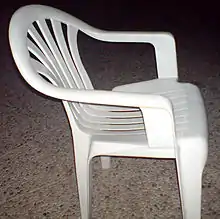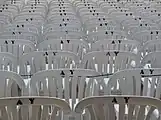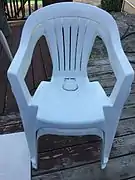Monobloc (chair)
The Monobloc chair is a lightweight stackable polypropylene chair, usually white in colour, often described as the world's most common plastic chair.[1][2] The name comes from mono- ("one") and bloc ("block"), meaning an object forged in a single piece.

Based on original designs by the Canadian designer D.C. Simpson in 1946, variants of the one-piece plastic chair went into production with Allibert Group and Grosfillex Group in the 1970s.[3] They were inspired by the Chair Universal 4867 design by Joe Colombo in 1965, but no patents were filed for a monobloc chair design.[4][5] Since then, millions have been manufactured in countries including Russia, Taiwan, Australia, Mexico, the United States, Italy, France, Germany, Morocco, Turkey, Israel, India and China. The Monobloc chair is named because it is injection moulded from thermoplastic as one piece rather than being assembled from multiple pieces. Many variations and styles exist but all are designed to allow the chair to be made quickly and cheaply through injection molding. A common thermoplastic used is thermoplastic polypropylene, with the granules being heated to about 220 degrees Celsius, and the melt injected into a mold.[6] The gate of the mould is usually located in the seat,[7] ensuring smooth flow to all parts of the tool.
Close to a billion Monoblocs have been sold in Europe alone, with one Italian manufacturer producing over ten million a year. Many design variants of the basic idea exist.[8] The chairs cost approximately $3.50 to produce, making them affordable across the world.[2] The stackable design aids setting up large gatherings and storage of the chairs afterwards.[9] Monobloc plastic chairs are prevalent in outdoor usage as design features like slits on seat and backrest let rain water and wind pass through and wide base makes it hard to tip over.[10] Social theorist Ethan Zuckerman describes the chair as having achieved a cultural global ubiquity.[2]
Monobloc plastic chairs were briefly banned from public spaces in the city of Basel, Switzerland from 2008[11] to 2017[12][13] to preserve the beauty of cityscape.
 A monobloc used at the beach, where it is not damaged by sand and water
A monobloc used at the beach, where it is not damaged by sand and water Monoblocs used for seating a large gathering of people
Monoblocs used for seating a large gathering of people Monoblocs left turned over
Monoblocs left turned over Two stacked monobloc chairs
Two stacked monobloc chairs Monobloc flotsam
Monobloc flotsam
Exhibitions
- 2017: Monobloc. A chair for the world at the Vitra Design Museum in Weil am Rhein.[14]
References
- "Is This the World's Most Famous Chair?". TreeHugger. Retrieved June 11, 2017.
- "Those White Plastic Chairs – The Monobloc and the Context-Free Object | … My heart's in Accra". Ethan Zuckerman. Retrieved February 23, 2020.
The Monobloc is one of the few objects I can think of that is free of any specific context. Seeing a white plastic chair in a photograph offers you no clues about where or when you are.
- Rashid, Karim. "A brief history of the humble plastic chair". CNN. Retrieved December 27, 2016.
- Suzdaltsev, Jules (January 28, 2015). "White Plastic Chairs Are Taking Over the World". VICE. Retrieved June 10, 2018.
- "Monobloc Chair: Joe Colombo and Vico Magistretti". Chairblog.eu. December 27, 2011. Retrieved June 10, 2018.
- Gosnell, Mariana (July 2004). "Everybody Take A Seat". Smithsonian.
- Chair, Misunderstood (Audio). Every Little Thing. July 3, 2017. Event occurs at 20 minute 20 seconds.
- "the monobloc plastic chair". designboom. Retrieved December 4, 2014.
- HAMADA, Midori (April 4, 2012). "A Cadeira Monobloco (The Monobloc Chair)". OBVIOUS Magazine (in Portuguese). Retrieved June 10, 2018.
- Niermann, Ingo (August 26, 2004). "Ingo Niermann: Plastic Chair". functionalfate.org. Archived from the original on January 21, 2008. Retrieved June 10, 2018.
- "Abschied von Plastikstühlen". Basler Zeitung (in German). ISSN 1420-3006. Archived from the original on August 8, 2008. Retrieved May 27, 2020.
- "Basel rüstet auf: Foodtrucks ab sofort erlaubt und Plastikstühle wieder willkommen". TagesWoche (in German). February 14, 2017. Archived from the original on November 7, 2018. Retrieved May 27, 2020.
- "Grossräte wollen die Lex Plastikstuhl zurück". TagesWoche (in German). March 20, 2017. Archived from the original on November 6, 2018. Retrieved May 27, 2020.
- Der Allgegenwärtige (The Omnipresent) in Frankfurter Allgemeine Zeitung. 30 April 2017, Page 53
External links
| Wikimedia Commons has media related to Monobloc (chair). |
- Designboom - History of the Monobloc
- Plastikstuhl - Blog dedicated to Monobloc Chairs
- Plasticchair.org – Blog aiming to gather a Monobloc plastic chair picture from every country
- Chair, Misunderstood: Learning to love a viral piece of furniture. - Podcast discussing history of the Monobloc by Gimlet Media
